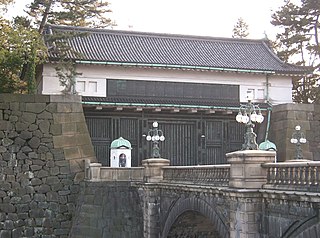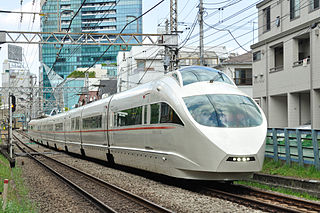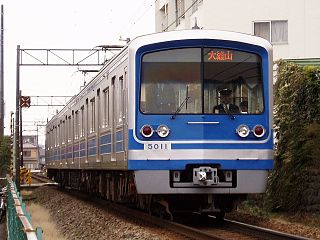
The Tokyo Imperial Palace is the primary residence of the Emperor of Japan. It is a large park-like area located in the Chiyoda ward of Tokyo and contains buildings including the main palace, the private residences of the Imperial Family, an archive, museums and administrative offices.

Hiratsuka is a city located in Kanagawa Prefecture, Japan.

The Odakyu Odawara Line is the main line of Japanese private railway operator Odakyu Electric Railway. It extends 82.5 km from Shinjuku in central Tokyo through the southwest suburbs to the city of Odawara, the gateway to Hakone in Kanagawa Prefecture. It is a busy commuter line and is also known for its "Romancecar" limited express services. From Yoyogi-Uehara Station some trains continue onto the Tokyo Metro Chiyoda Line and beyond to the East Japan Railway Company Joban Line.

Fuji-Hakone-Izu National Park is a national park in Yamanashi, Shizuoka, and Kanagawa Prefectures, and western Tokyo Metropolis, Japan. It consists of Mount Fuji, Fuji Five Lakes, Hakone, the Izu Peninsula, and the Izu Islands. Fuji-Hakone-Izu National Park covers 1,227 square kilometres (474 sq mi).

Nijō Castle is a flatland castle in Kyoto, Japan. The castle consists of two concentric rings (Kuruwa) of fortifications, the Ninomaru Palace, the ruins of the Honmaru Palace, various support buildings and several gardens. The surface area of the castle is 275,000 square metres, of which 8,000 square metres (86,000 sq ft) is occupied by buildings.

Odawara Station is a railway station in Odawara, Kanagawa, Japan. It is a gateway station to the Hakone area.

Hakone Gardens is a traditional Japanese garden in Saratoga, California, United States. A recipient of the Save America's Treasures Award by the National Trust for Historic Preservation, it is recognized as one of the oldest Japanese-style residential garden in the Western Hemisphere, and an enduring American treasure. Notable features include a bamboo garden, a Zen garden, a strolling garden, tea houses, and the Cultural Exchange Center, which is an authentic reproduction of a 19th-century Kyoto tea merchant's house and shop.

Akasaka Palace, or the State Guest House, is one of the two State Guesthouses of the Government of Japan. The palace was originally built as the Imperial Palace for the Crown Prince in 1909. Today the palace is designated by the government of Japan as an official accommodation for visiting state dignitaries. Located in the Moto-Akasaka, Minato, Tokyo, the building took on its present function in 1974, having previously been an imperial detached palace. In 2009 the palace was designated as a National Treasure of Japan.

The Shugaku-in Imperial Villa, or Shugaku-in Detached Palace, is a set of gardens and outbuildings in the hills of the eastern suburbs of Kyoto, Japan. It is one of Japan's most important large-scale cultural treasures; its gardens are one of the great masterpieces of Japanese gardening.

National Route 1 is a major highway on the island of Honshū in Japan. It connects Chūō, Tokyo in the Kantō region with the city of Osaka, Osaka Prefecture in the Kansai region, passing through the Chūbu region en route. It follows the old Tōkaidō westward from Tokyo to Kyoto, and the old Kyo Kaidō from there to Osaka. Between Tokyo and Aichi Prefecture it parallels the Tomei Expressway; from there to Mie Prefecture, the Higashimeihan Expressway, and from Shiga Prefecture to Osaka, the Meishin Expressway. Its total length is 565.4 kilometres (351.3 mi). At its eastern terminus in Nihonbashi, Chūō, Tokyo, it meets National Routes 4, 6, 14, 15, 17, and 20. At its western terminus in Umeda, Kita-ku, Osaka, it links with Routes 2, 25, 26 and other highways.

The Imperial House of Japan, also referred to as the Imperial Family or the Yamato Dynasty, comprises those members of the extended family of the reigning Emperor of Japan who undertake official and public duties. Under the present Constitution of Japan, the Emperor is "the symbol of the State and of the unity of the people". Other members of the Imperial Family perform ceremonial and social duties, but have no role in the affairs of government. The duties as an Emperor are passed down the line to their children and so on.

Lake Ashi, also referred to as Hakone Lake or Ashinoko Lake, is a scenic lake in the Hakone area of Kanagawa Prefecture in Honshū, Japan. It is a crater lake that lies along the southwest wall of the caldera of Mount Hakone, a complex volcano that last erupted in 1170 CE at Ōwakudani. The lake is known for its views of Mt. Fuji, its numerous hot springs, historical sites, and ryokan. The lake is located on the Tōkaidō road, the main link between Kyoto and Tokyo. A number of pleasure boats and ferries traverse the lake, providing scenic views for tourists and passengers. Several of the boats are inspired by the design of sailing warships.

Prince Hachijō Toshihito was a court noble of Japan during the Sengoku period. Toshihito was the younger brother of Emperor Go-Yōzei. After 1588 Toyotomi Hideyoshi adopted Toshihito in an effort to greatly strengthen the Toyotomi and the Imperial ties. In 1590, Hideyoshi gave Toshihito 3,000 koku worth of land and was slated to act as Hideyoshi's governor of Japan during China's anticipated cession of influence in Korea during the invasions of 1592–1593.

The Museum of the Imperial Palace of Manchukuo is a museum in the northeastern corner of Changchun, Jilin province, northeast China. The palace was the official residence created by the Imperial Japanese Army for China's last emperor Puyi to live in as part of his role as Emperor of the Japanese puppet state of Manchukuo. In the People's Republic of China the structures are generally referred to as the Puppet Emperor's Palace & Exhibition Hall. It is classified as a AAAAA scenic area by the China National Tourism Administration.

The Izuhakone Railway is a railway company in Kanagawa Prefecture and Shizuoka Prefecture, Japan. The company also operates excursion ships, and the group companies operate buses and taxis. The company has its roots in Zusō Railway founded in 1893. Izuhakone Railway is a member of Seibu group. The Daiyūzan Line accepts PASMO, a smart card ticketing system.

Hayama Imperial Villa, located in the town of Hayama, Kanagawa Prefecture, Japan is a residence owned by the Japanese Imperial Family, and used on infrequent intervals as an informal winter retreat.

Emperor Taishō was the 123rd Emperor of Japan, according to the traditional order of succession, reigning from 30 July 1912 until his death on 25 December 1926.

The Hakone Shrine is a Japanese Shinto shrine on the shores of Lake Ashi in the town of Hakone in the Ashigarashimo District of Kanagawa Prefecture. It is also known as the Hakone Gongen (箱根権現).





















